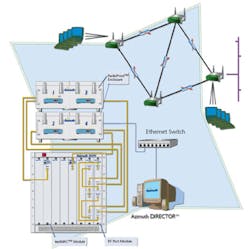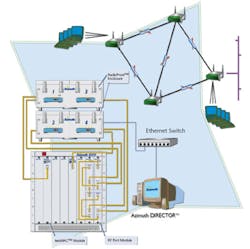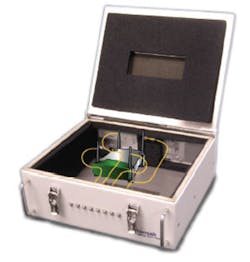A new and resilient Internet infrastructure presents a set of unique testing challenges.
Wireless mesh networking, combining performance, simplicity, and economics, can be used when wired backhaul networks are impractical in applications such as municipal wireless networks, public safety, healthcare, and education. In fact, a recent ABI Research report forecasts a $1.2 billion market for citywide Wi-Fi networks by 2010, and more than 50 municipalities including Chicago, Houston, Philadelphia, and San Francisco already have installed wireless metropolitan networks with several others currently in the deployment process.
Carriers and service providers understand the costs involved in the wide adoption of early-stage technologies and that their customers will not tolerate unreliable new services. If an unpredictable network is deployed, the service provider bears the challenge and cost of customer support and troubleshooting.
If Wi-Fi is to effectively compete with technologies such as CDMA-2000 EV-DO, WCDMA, and UMTS, the technology must evolve from its low-cost consumer roots to a carrier-grade infrastructure with improved performance and robustness. To guarantee the success of wireless mesh technology and establish its credibility for metro-area network applications, carriers and service providers require reliable predeployment testing.
Step-by-step predeployment testing in a controlled laboratory environment is the most efficient way of introducing complicated networking technology such as wireless mesh networking. Thorough testing reveals technological flaws and weaknesses, helping vendors fix problems before product shipment.
Such testing must be automated or it lacks the scalability to test all possible load, motion, background interference, and device configuration scenarios. The absence of automation may allow bugs and network vulnerabilities to remain unchecked.
Wireless mesh networks present unique testing challenges because this wide-area infrastructure supports mobile users and high-throughput data, voice, and video applications. Wireless mesh nodes use sophisticated routing algorithms to direct traffic to its destination instead of connecting through traditional cabled backhaul. For that reason, mesh nodes cannot be tested in the same way as single-access points. They must be tested together as a self-configuring, self-healing system.
Mesh Networking Performance Variables
Mesh nodes discover each other and determine the optimum frequency scheme for communicating with neighboring nodes and local clients. Because they promptly respond to environmental changes and fault conditions by rerouting traffic or reconfiguring the frequency channel scheme, mesh nodes must constantly be aware of network conditions.
The most critical factors impacting user satisfaction in a communications network are throughput and quality of service (QoS). In a Wi-Fi mesh system, throughput degrades as the number of hops increases. QoS for voice and video is highly dependent on throughput, packet loss, delay, and jitter, which also increase with each successive hop. When testing mesh networks for performance variables, measurements should be performed over different hop counts and plotted vs. hops.
A variety of device and network settings impacts mesh performance and should be measured in a controlled laboratory environment. Some of these variables, such as range, equipment and vendor interoperability, and interference, are applicable to all Wi-Fi network testing. However, a number of variables affect mesh performance:
Node Client Capacity
Node client capacity shows the capability of individual mesh nodes to scale to a large number of clients. Because mesh deployments are primarily well suited for and targeted at municipal or public access hotspots, conference centers, libraries, and hotels, the number of users may be high at times, fluctuate considerably, and have different demands.
Multihop Throughput Performance
Multihop throughput performance measures the throughput for varied topologies and node configurations. Network size is critical in mesh networking. As the deployments succeed and the benefits are justified, customers will want to expand their networks to include bigger and bigger deployments over wider and more difficult coverage areas.
As deployment size increases, so will the number of nodes traversed from a user to the backhaul wired link. Each additional hop can potentially increase the network delay. In addition, the amount of background traffic and the number of network users increase assuming each node also is a user�s node, not only a relay.
Call Capacity
Call capacity tests the capability of the mesh network to deliver real-time services like VoIP. Voice call capacity and quality are measurements of voice traffic across multiple hops and with varying background traffic.
The promise of fixed-mobile convergence/Wi-Fi to cellular roaming such as better coverage, a decrease in dropped calls, and high-quality voice has many service providers ready to jump in the market. Mesh networks must meet this new level of service in addition to allowing regular data access. QoS-specific functions are a key part of supporting real-time communications traffic.
Node Roaming
Node roaming tests verify the robustness of the network design, autoconfiguration, and failure recovery through smooth node-to-node transition. Mesh networks can reroute traffic from a user through different routes; however, each vendor uses its own approach to make this happen seamlessly and efficiently. Evaluating the speed and disruption caused in making this transition will factor into the user�s experience as the system changes.
In addition, Wi-Fi access for radio, TV, phone, and other services is an appealing concept. But if the service is spotty, the user base will revolt. Discovery and self-healing of user connection and node-to-node connections are critical to operation.
Security Tests
Security tests include security performance and multi-basic service set identifier (BSSID) isolation. Security performance measures the impact on performance for different security protocols. Private networks such as the library network, municipal employees� network, or leased virtual corporate networks use security and operate in parallel with other secure and open public networks. This test is focused at the load that security adds to the network and whether it affects other network functions.
Mesh Networking Test Methodology
Performance of wireless mesh devices and systems must be verified under controlled conditions that allow the causes of poor performance to be easily isolated and managed. Multi-radio mesh test setups can be configured for controlled laboratory testing by interconnecting various mesh topologies using a conducted test setup.
By using multiple radios, mesh networks can segregate local client traffic and backhaul traffic to multiple simultaneous channels. Mesh networks that use multi-radio nodes with different channels that communicate with neighboring nodes and local clients tend to have better throughput than early single-radio implementations, which shared one channel for client and backhaul traffic. As the number of radios in mesh nodes significantly impacts performance, measurements must be made with different numbers of radios activated.
An example of how a simple mesh topology can be configured is shown in Figure 1. Mesh nodes are interconnected using programmable or fixed attenuators to emulate a variety of path losses causing the mesh to self-configure and select backhaul and client channels. Client traffic can be emulated using specialized test equipment. Throughput and QoS measurements can be performed at different points in the mesh and cover multiple hops.
Figure 1. Mesh Test Configuration
Conducted test setups use shielded enclosures to isolate each mesh node from neighboring nodes to control signal flows through the intended conducted paths instead of coupling over the air (Figure 2). Each mesh node in the test setup must be placed in a shielded isolation chamber with all the radio antenna ports cabled to the outside world for interconnection in a test network. This ensures that each mesh node communicates with clients or neighboring nodes through conducted paths rather than through uncontrolled coupling. Isolation chambers also protect against external interference, making the testing robust and repeatable.
By interconnecting a variety of network topologies in a conducted test setup, the factors affecting throughput and QoS such as packet loss, delay, and jitter can be measured in a controlled laboratory environment. Using programmable attenuators, path losses can be varied among mesh nodes, which allow the verification of a mesh network�s self-configuration and self-healing capabilities.
Programming high attenuation on an active backhaul interconnection forces the mesh to redirect the traffic flow so fail-over conditions can be created dynamically and in a controlled manner. Throughput and QoS performance should be measured under both fail-over and normal conditions.
Settings That Impact Mesh Performance
When testing wireless mesh networks, it also is critical to measure a variety of device and network settings that impact mesh performance. These configurations should be varied in a controlled laboratory environment as the measurements are performed. Several settings for mesh tests that impact mesh performance include the following:
Hop Measurements
Throughput and QoS are directly impacted by the number of hops through the mesh network. Hops equal the number of nodes traversed between the user device and the high-throughput wired backhaul network. Traffic load from groups of clients using data, voice, and video services should be emulated along with IEEE 802.11e prioritization for voice, data, and video per group with a variety of traffic loads and packet sizes. Additionally, performance must be measured for incrementing numbers of mesh hops.
Interfering Traffic Load
Each mesh node routes local traffic and forwards traffic from other nodes via its backhaul links. Depending on the efficiency of the routing algorithms, congestions can occur on backhaul links, impacting performance of the entire mesh. Configuring a traffic source and destination addresses to exercise routing logic should be performed in a controlled laboratory test.
Direction of Traffic Flow
Throughput and QoS must be measured in upstream and downstream directions. The test application should allow controlled upstream, downstream, and bidirectional measurements.
Security and QoS Setting
Throughput and routing efficiency may be impacted by security settings. To determine this impact, test with a variety of standard IEEE 802.11i security settings for groups of emulated clients. Emulate a mix of data, voice, and video clients with different QoS profiles while measuring throughput to test the capability of mesh infrastructure to prioritize voice and video over data. Additionally, the test should plot voice and video quality metrics vs. hops, load, and other settings.
Distance Between Nodes
The RF conditions and loss between any two nodes like path loss and multipath conditions can have a significant effect on the performance of the system. Longer distances and other variances between clients and mesh nodes should be used to measure and plot throughput vs. path loss and multipath models. This allows the capability to test the resilience of the system to changing conditions and estimate the optimal operating conditions. The test also should use programmable path loss and multipath to emulate failure conditions and cause traffic-flow reconfiguration.
Interference
Throughput and QoS performance are affected by interference. Co-channel and adjacent channel interference (ACI) are normal in mesh networks since neighboring radios can communicate on the same or adjacent channels and interfere with the channel under test. Throughput and QoS measurement should be performed in the presence of co-channel interference and ACI.
Mobility Conditions
The most challenging and important test parameter to control is mobility. Emulate motion of clients with respect to mesh nodes, motion of mesh nodes with respect to other mesh nodes, and multiple clients moving at the same time. Different velocities of motion such as people walking and mesh nodes on buses and trains should be measured along with different cell overlap conditions.
Conclusion
Wireless mesh networking technology is emerging as the primary infrastructure for several broadband services including wide-area voice and data transmission. To properly establish its credibility for metro-area network applications, predeployment testing of mesh networks must benchmark performance testing in a controlled laboratory environment. Automated, standardized, repeatable test methodology will ensure the scalability of the system to support load, motion, background interference, and device configuration scenarios as well as identify bugs and network vulnerabilities prior to deployment.
Methodical lab testing evaluates feasibility and catches problems with early implementations prior to being introduced into the field where finding problems is logistically challenging and costly. With thorough testing, mesh networks can be deployed on a large scale more confidently.
About the Author
Graham Celine is the senior director of marketing at Azimuth Systems. He has more than 15 years of high-tech experience, joining Azimuth after a 13-year career focused on data networking. Mr. Celine received a BSc in electrical engineering from University of the Witwatersrand. Azimuth Systems, 31 Nagog Park, Acton, MA 01720, 978-263-6610, e-mail: [email protected]
FOR MORE INFORMATION
www.rsleads.com/608ee-185
August 2006


